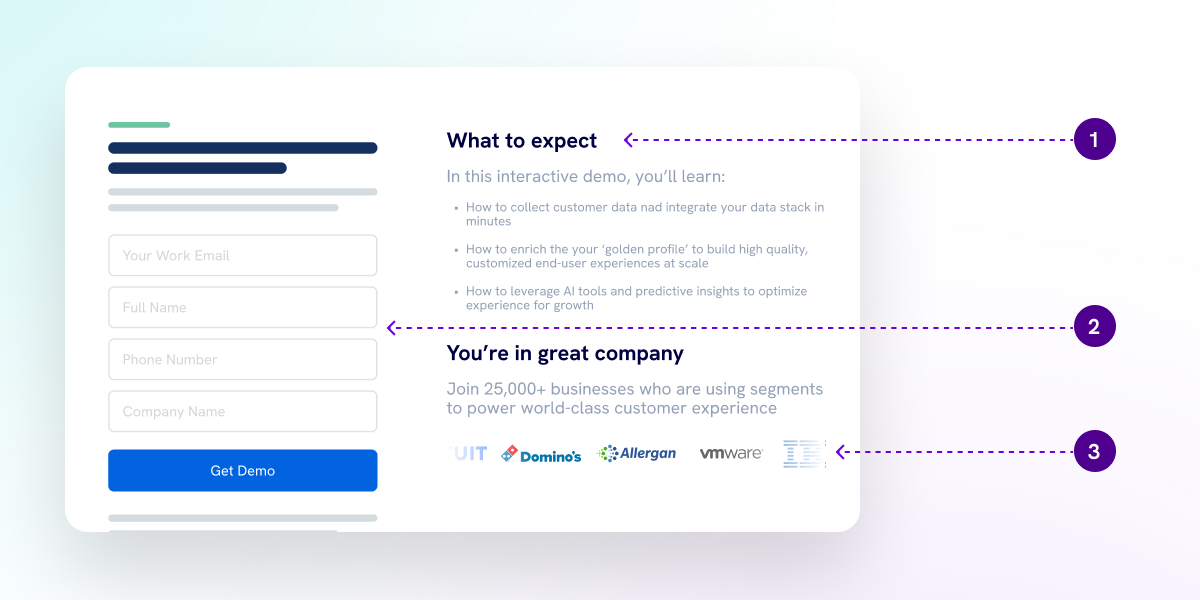3 Ways to Minimize Friction on Your Demo Page

When someone clicks “Request a Demo,” they’re already halfway down the funnel. Here’s how to reduce drop-off, and turn more demo requests into actual conversations.
Let’s paint a common scene in the B2B world:
A prospect lands on your website. They click “Request a Demo.” This is a high-intent moment. The digital equivalent of someone walking into your store and saying, “I’d like to see what you sell.”
But instead of showing them the product, we stall the momentum.
We hit them with a long form. Name, title, company size, industry, phone number, revenue bracket—sometimes even qualifying questions like, “Are you evaluating other vendors?”
It’s like saying, “Are you sure you want this?”
Think about that. Nearly 7 out of every 10 people who raise their hand with intent are quietly walking away—not because they changed their mind about your product, but because the experience made them second-guess the decision.
This is what I call conversion friction.
What Would You Do at a Trade Show?
Let’s step offline for a moment. Imagine you’re at a busy tech conference. A booth visitor walks up, scans your signage, and says, “I’d love to see how your platform works.” Do you say:
“Sure, but first, can you fill out this 7-question form?” Of course not.
You smile, shake their hand, and say, “Absolutely! Let me walk you through it.” Then, as the conversation flows, you naturally gather details about their company, their role, and their pain points. We prioritize connection and momentum. But online, we often reverse that order.
Three Ways to Optimize Your Demo Page (That Don’t Kill Conversion)

1. Provide a Concise Overview of the Demo
Prospects don’t click “Request a Demo” just to see a product—they click because they’re trying to solve a problem. But if your demo page doesn’t tell them what to expect, what problems will it address, and why it’s worth their time, they’ll hesitate.
What most companies get wrong: They restate product benefits instead of clarifying the demo experience.
Instead: Write a short description of what will be covered during the demo.
2. Reduce the Number of Required Fields
Every field you add to a form is a mini-hurdle. Yet many demo pages still include 6–10 fields—everything from “industry” to “company size”. A workaround: Use Tools like ZoomInfo, Clearbit, 6sense, and Demandbase to enrich contact data after someone submits just their email. You don’t need to ask for the company size or industry—they automatically provide you that information.
3. Validate Your Solution via Social Proof
When someone is seconds away from submitting their contact info, one of the last questions they ask themselves is:
“Does their solution fit our company size?”
“Do other companies trust them?”
“Will this work in our industry?”
You can answer all three with trust signals.
- Mini case studies: Pull 1–2 sentence quotes from companies in your prospect’s vertical.
- Video testimonials: If you’ve got one, place a short 30–60 sec customer video right next to the form or below the fold.
- Review snapshots: Pull in a 4.8-star rating from G2 or Capterra with 1–2 highlighted reviews.
- Familiar logos in context: Instead of a wall of 50 logos, show 4–6 that match your ideal customer’s industry, size, or use case. The goal isn’t just trust, it’s relatability. People want to see themselves in your success stories.